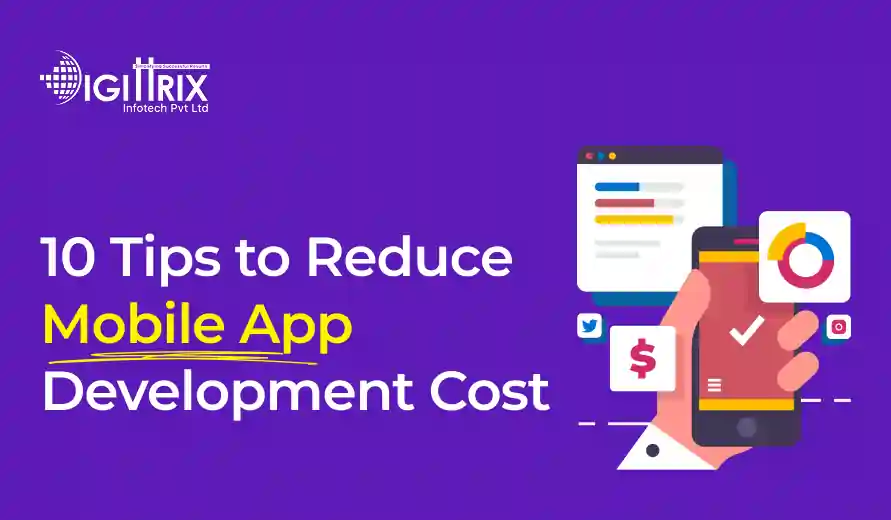Reduce mobile app development costs with smart planning, MVPs, open-source tools, outsourcing, and phased rollouts, providing affordable, high-quality apps for businesses and startups worldwide today.
Highlights
With Over 14 years of Experience in the IT Field, Helping Companies Optimise there Products for more Conversions

In today’s world, almost every business—large or small—strives to connect with customers via a mobile app. It’s expected, since apps have become part of everyday life. However, the cost of mobile app development can sometimes stop startups or small businesses from turning their ideas into reality.
Many business owners think that building an app always needs a big budget, but that’s not true. With proper planning and the right approach, you can reduce costs without losing quality. The process requires a strategy, smart decisions, and careful execution.
This guide provides 10 practical tips to reduce mobile app development costs. Each tip includes examples to help you save money while still building an app your users will enjoy.
Curious how AI is transforming mobile apps in 2025? Discover the most impactful AI trends shaping mobile apps with Digittrix’s insightful guide!
Every app begins with an idea, but transforming that idea into a functional product requires clarity. A major reason costs escalate is poor planning. If you don’t specify the features you want, developers will have to guess, make revisions, or redo parts—each adding to the overall cost.
Start by answering these simple but important questions:
For example, if you're building a food delivery app, essential features might include restaurant listings, placing orders, and payment integration. Features like loyalty rewards or personalized recommendations can be added later.
By clearly defining your needs, you not only cut down on development costs but also assist an app development firm in providing accurate estimates.
Many businesses make the mistake of launching with a full set of features. This approach wastes time, money, and resources, and it doesn’t guarantee success. Instead, focus on creating a Minimum Viable Product (MVP).
An MVP is a basic version of your app that only has the essential features. After launching, you can gather feedback from early users. If they like it, you can put more money into developing extra features. If they don’t, you’ve saved money by avoiding unnecessary development.
For example, Instagram’s initial version focused solely on photo sharing with filters. Over time, it added stories, reels, shopping, and more. This gradual process helps businesses manage their budgets while steadily improving their apps.
The development method you choose significantly impacts the cost. There are two main approaches:
If your app needs to extensively utilize device features like GPS, Bluetooth, or advanced graphics, native development might be necessary. However, if your app primarily focuses on content or transactions (such as e-commerce or booking apps), cross-platform tools like Flutter or React Native can lower costs without compromising the user experience.
By analyzing your requirements, you can select the right approach and avoid overspending.
Hiring full-time developers can be expensive, considering salaries, benefits, and infrastructure costs. Outsourcing offers a more budget-friendly alternative. Working with an app development company or freelancers provides access to experts without the need for long-term commitments.
Outsourcing offers flexibility as a key benefit. It allows you to hire developers for specific projects and pay only for the work done. Additionally, outsourcing enables you to select teams from regions where development costs are lower. For example, hourly rates in South Asia or Eastern Europe are often significantly lower than those in North America.
However, you must choose your outsourcing partner carefully. Check reviews, examine their portfolio, and discuss communication methods early on. A reliable partner providing app development services can complete your project at a fraction of the cost of building an in-house team.
Creating everything from scratch isn't necessary. Many ready-to-use components are available that can save time and money.
For example:
Instead of building these features yourself, developers can quickly incorporate these tools. This reduces coding hours and testing time.
For example, if you want to add maps to your app, using the Google Maps API is faster and more affordable than building your own mapping system. Such smart choices reduce costs without sacrificing your app's quality.
Not every feature needs to be included in the initial release. Using a phased rollout plan lets you launch sooner, save money, and make improvements based on actual user needs.
Here’s how it works:
This approach helps avoid overspending on unnecessary features. For example, a ride-sharing app might start with booking and tracking options. Later, it can add carpooling, subscription plans, or referral incentives.
Many businesses prefer this approach in custom app development because it helps manage budgets more effectively.
The location of your developers influences overall costs. Hiring in countries with higher living expenses can quickly drain your budget. Offshore or nearshore development teams provide skilled professionals at lower hourly rates.
For example:
Choosing offshore teams can save you a lot of money. But always weigh cost against quality. It’s smarter to pay a little extra for experienced developers than to risk delays and bugs from less skilled ones.
This option is perfect for startups or businesses aiming to save costs without sacrificing their expectations.
Open-source tools are free and have strong support from developer communities. They reduce licensing expenses and provide flexibility in customization.
For instance:
Using open-source resources is especially valuable in on-demand app development, where quick deployment and low costs are priorities. Since many developers are familiar with these tools, you also reduce time spent on training and debugging.
Designing an app isn’t just about colors and logos; it’s about creating an easy-to-use experience for users. If design planning is overlooked, the final result could be confusing interfaces that require expensive redesigns later.
Starting with wireframes, prototypes, and user flow charts decreases the chance of mistakes. Finalizing the design early helps developers stick to a clear plan, saving time and money.
For example, if you’re developing an ecommerce app, sketching out the product page, cart, and checkout helps prevent confusion later. This early clarity avoids unnecessary revisions that can increase costs.
Simple designs save money and offer users a better experience.
Many business owners believe their work ends once the app launches. In reality, maintenance is ongoing. Apps need updates for bug fixes, compatibility with new operating systems, and improved features.
Ignoring maintenance can lead to higher costs later if issues build up. A smart approach is to set aside part of your budget for updates. Working with a partner who provides app development services, including maintenance, can help you avoid unexpected large expenses.
Think of it this way: just as a car needs regular service to run smoothly, apps need consistent updates to function properly. Planning helps you avoid unexpected breakdowns and expenses.
Building on iOS in 2025? Check out Digittrix’s top iOS app development frameworks to choose the right tech for your next project!
Lowering mobile app development costs requires making smart choices rather than cutting corners. Whether you’re designing for customers or internal use, careful planning, utilizing open-source tools, and concentrating on essential features can greatly influence the project's success.
Choosing the right experts—whether it’s an Android app developer, an iOS app developer, or a trusted outsourcing partner—is also essential. By following the tips shared in this guide, you can stay within your budget while still creating a product that provides real value.
For businesses exploring custom or on-demand app development, these strategies provide a way to create apps that are practical, cost-effective, and easy to use. Saving money doesn’t mean sacrificing quality; it means being smart about where and how you allocate your resources.
Managing the budget in mobile app development requires careful planning, smart feature choices, and the right technical expertise. At Digittrix, we understand the importance of balancing cost and quality. Our team offers custom app development solutions that focus on key features, practical technology options, and long-term value.
Whether you need on-demand app development, cross-platform solutions, or dedicated experts such as an Android or iOS app developer, Digittrix can help you achieve your goals. With our extensive experience in providing comprehensive app development services, we guide you from idea to launch while effectively managing costs.
If you’re ready to reduce development costs and still build an effective mobile app, contact us today. Call +91 8727000867 or email digittrix@gmail.com to discuss your project. Let’s turn your app idea into reality without overspending.

Do you need help in Mobile App development?




Join over 1500+ businesses we've already helped!
You can save money by clearly planning features, starting small, reusing tools, and outsourcing work to skilled teams instead of hiring full-time staff.
Yes, outsourcing typically lowers expenses because you pay only for the project and avoid extra costs like salaries, benefits, or office space.
Yes, using a shared codebase for both platforms helps save time and money compared to developing separate apps for each system.
Launching a basic version, or MVP, helps test your idea with real users before investing more in advanced features.

©2025Digittrix Infotech Private Limited , All rights reserved.